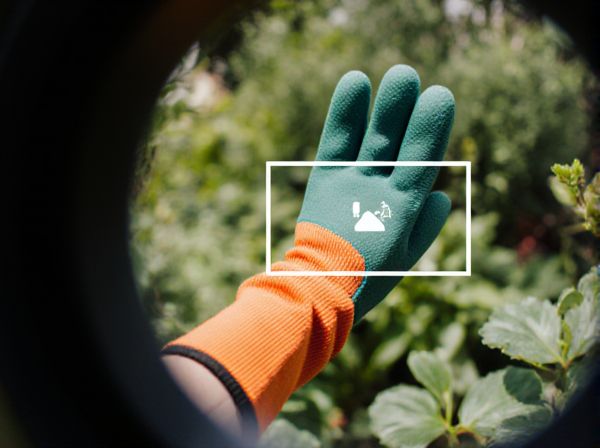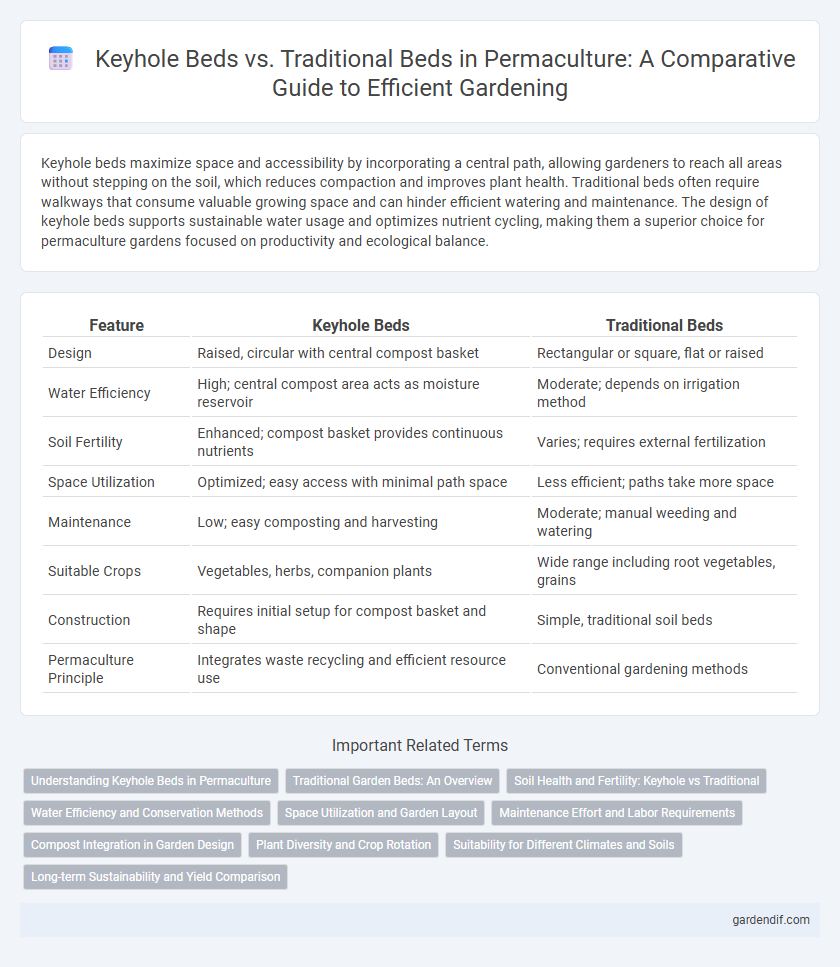
Keyhole Beds vs Traditional Beds Illustration
Keyhole beds maximize space and accessibility by incorporating a central path, allowing gardeners to reach all areas without stepping on the soil, which reduces compaction and improves plant health. Traditional beds often require walkways that consume valuable growing space and can hinder efficient watering and maintenance. The design of keyhole beds supports sustainable water usage and optimizes nutrient cycling, making them a superior choice for permaculture gardens focused on productivity and ecological balance.
Table of Comparison
| Feature | Keyhole Beds | Traditional Beds |
|---|---|---|
| Design | Raised, circular with central compost basket | Rectangular or square, flat or raised |
| Water Efficiency | High; central compost area acts as moisture reservoir | Moderate; depends on irrigation method |
| Soil Fertility | Enhanced; compost basket provides continuous nutrients | Varies; requires external fertilization |
| Space Utilization | Optimized; easy access with minimal path space | Less efficient; paths take more space |
| Maintenance | Low; easy composting and harvesting | Moderate; manual weeding and watering |
| Suitable Crops | Vegetables, herbs, companion plants | Wide range including root vegetables, grains |
| Construction | Requires initial setup for compost basket and shape | Simple, traditional soil beds |
| Permaculture Principle | Integrates waste recycling and efficient resource use | Conventional gardening methods |
Understanding Keyhole Beds in Permaculture
Keyhole beds in permaculture are designed to maximize space and accessibility by incorporating a central composting basket surrounded by planting areas, allowing efficient nutrient cycling and soil enrichment. Unlike traditional beds, keyhole beds reduce soil compaction and water wastage through better soil aeration and moisture retention achieved with their unique circular layout. This design supports sustainable gardening practices by enhancing biodiversity, improving yield per square meter, and simplifying maintenance tasks.
Traditional Garden Beds: An Overview
Traditional garden beds follow linear or rectangular layouts that maximize planting area and simplify irrigation and maintenance. These beds often require more walking space between rows, which can reduce overall growing space but improve accessibility. Construction typically involves raised or in-ground soil preparation to enhance root development and water retention.
Soil Health and Fertility: Keyhole vs Traditional
Keyhole beds enhance soil health by promoting better aeration and nutrient cycling through their compact, circular design that reduces soil compaction and water runoff. Traditional beds often suffer from less efficient nutrient distribution and increased soil erosion due to linear planting rows and frequent foot traffic. The central composting basket in keyhole beds enriches fertility by continuously supplying organic matter directly to the root zones, outperforming traditional beds in sustaining long-term soil vitality.
Water Efficiency and Conservation Methods
Keyhole beds maximize water efficiency by directing rainfall and irrigation to a central compost basket, allowing moisture to radiate outward and reduce evaporation. Traditional beds often experience uneven water distribution, leading to increased runoff and water waste. Incorporating mulch and organic matter in keyhole beds enhances water retention and conserves soil moisture, making them superior for sustainable water management in permaculture gardens.
Space Utilization and Garden Layout
Keyhole beds maximize space utilization by incorporating a central composting basket, allowing gardeners to reach all areas without stepping on the soil, which minimizes compaction and promotes healthy root growth. Traditional garden beds typically require wider pathways between rows, reducing overall planting area and potentially disrupting garden layout efficiency. The radial design of keyhole beds enhances accessibility and soil fertility management, optimizing both garden productivity and spatial organization.
Maintenance Effort and Labor Requirements
Keyhole beds significantly reduce maintenance effort by centralizing pathways, allowing easy access to all planting areas without stepping on the soil, which minimizes compaction and labor-intensive weeding. Traditional beds often require more frequent soil turning and physical strain from bending and reaching across wider planting zones, increasing overall labor demands. The design of keyhole beds enhances efficiency in watering, harvesting, and soil amendment application, making them an ideal choice for permaculture systems focused on sustainable labor management.
Compost Integration in Garden Design
Keyhole beds maximize compost integration by placing the compost basket at the center, allowing nutrients to diffuse evenly into surrounding soil and plants. This design enhances soil fertility and moisture retention more efficiently than traditional beds, which often require separate composting areas. The close proximity of organic matter in keyhole beds accelerates microbial activity, promoting healthier plant growth and sustainable garden ecosystems.
Plant Diversity and Crop Rotation
Keyhole beds maximize plant diversity by allowing growers to cultivate a wide range of complementary crops within a compact, easily accessible space, enhancing nutrient cycling and pest control. Traditional beds often have limited crop rotation options due to their linear or rectangular layout, which can deplete soil nutrients and increase vulnerability to pests. Crop rotation in keyhole beds promotes soil health and sustainable yields by integrating diverse plant species that support natural soil fertility and reduce disease buildup.
Suitability for Different Climates and Soils
Keyhole beds excel in arid and nutrient-poor soils by enhancing water retention and concentrating compost in the central basket, making them ideal for dry or depleted environments. Traditional beds perform well in fertile, well-drained soils where wide planting areas allow extensive root growth and ease of crop rotation. Adapting bed design to local climate and soil conditions maximizes yield and sustainability in permaculture systems.
Long-term Sustainability and Yield Comparison
Keyhole beds enhance long-term sustainability by maximizing space efficiency and improving soil health through integrated composting at the bed's center, leading to higher nutrient retention and reduced water usage compared to traditional beds. This design promotes greater biodiversity and microbial activity, which supports stronger plant growth and increased yields over multiple growing seasons. Traditional beds often suffer from soil compaction and nutrient depletion, resulting in lower productivity and a greater need for external inputs, making keyhole beds a superior choice for sustainable, high-yield permaculture gardening.
Keyhole Beds vs Traditional Beds Infographic

 gardendif.com
gardendif.com